
- CN 62-1070/P
- ISSN 1000-694X
- Bimonthly 1981

Journal of Desert Research ›› 2022, Vol. 42 ›› Issue (4): 229-241.DOI: 10.7522/j.issn.1000-694X.2022.00095
Shihua Zhu1,2( ), Xia Fang3,4(
), Xia Fang3,4( ), Xin Hang1, Xiaoping Xie1, Liangxiao Sun1, Liangzhong Cao4,5
), Xin Hang1, Xiaoping Xie1, Liangxiao Sun1, Liangzhong Cao4,5
Received:2022-03-22
Revised:2022-06-01
Online:2022-07-20
Published:2022-08-29
Contact:
Xia Fang
CLC Number:
Shihua Zhu, Xia Fang, Xin Hang, Xiaoping Xie, Liangxiao Sun, Liangzhong Cao. Normalized difference vegetation index ( NDVI ) dynamics of grassland in Central Asia and its response to climate change and human activities[J]. Journal of Desert Research, 2022, 42(4): 229-241.
Add to citation manager EndNote|Ris|BibTeX
URL: http://www.desert.ac.cn/EN/10.7522/j.issn.1000-694X.2022.00095
| 类别 | 情景 | Slope(NDVIp) | Slope(NDVIr) | 气候变化贡献 | 人类活动贡献 | 描 述 |
|---|---|---|---|---|---|---|
| 植被改善区 | S1 | >0 | >0 | 共同作用 | ||
| S2 | >0 | <0 | 0 | 气候因子主导 | ||
| S3 | <0 | >0 | 0 | 人类活动主导 | ||
| 植被退化区 | S4 | <0 | <0 | — | — | 共同作用 |
| S5 | <0 | >0 | — | 0 | 气候因子主导 | |
| S6 | >0 | <0 | 0 | — | 人类活动主导 |
Table 1 Method for determining relative contributions of climate change and human disturbance to NDVI variations
| 类别 | 情景 | Slope(NDVIp) | Slope(NDVIr) | 气候变化贡献 | 人类活动贡献 | 描 述 |
|---|---|---|---|---|---|---|
| 植被改善区 | S1 | >0 | >0 | 共同作用 | ||
| S2 | >0 | <0 | 0 | 气候因子主导 | ||
| S3 | <0 | >0 | 0 | 人类活动主导 | ||
| 植被退化区 | S4 | <0 | <0 | — | — | 共同作用 |
| S5 | <0 | >0 | — | 0 | 气候因子主导 | |
| S6 | >0 | <0 | 0 | — | 人类活动主导 |
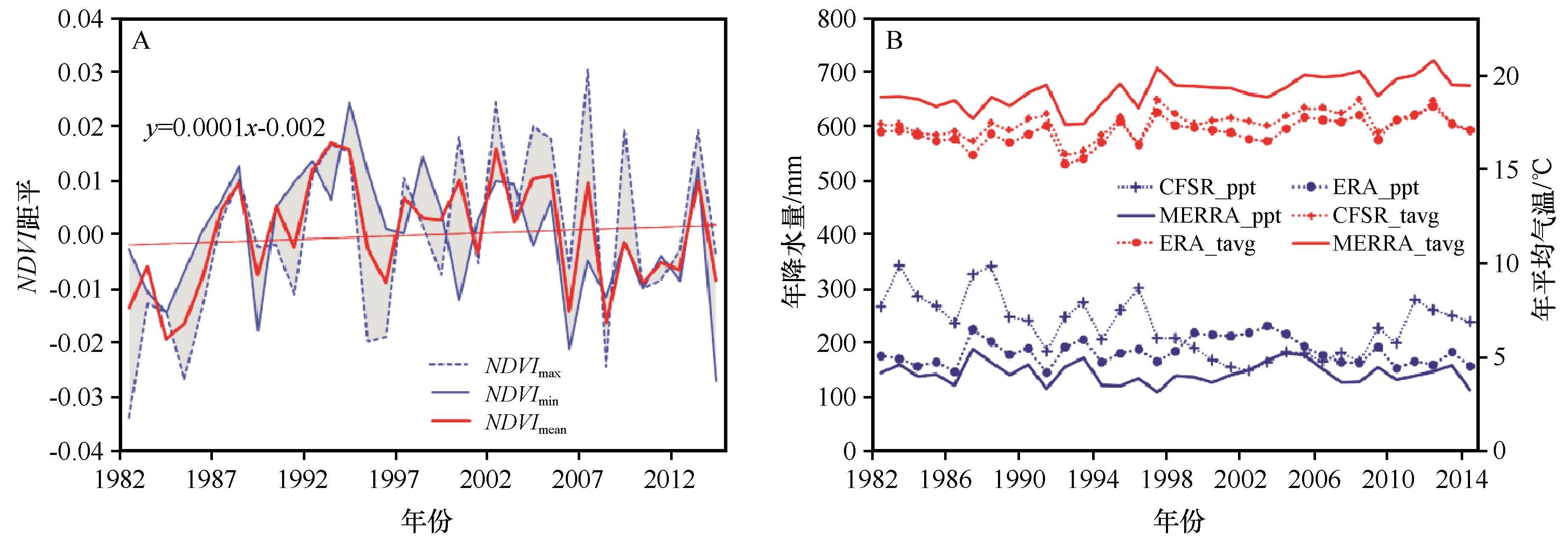
Fig. 2 Anomalies of growing season NDVImax, NDVImin and NDVImean (A) and anomalies of annual mean of temperature (tavg) and annual total precipitation (ppt) calculated from CFSR, MERRA, and ERA-interim reanalysis data (B) over grasslands in Central Asia during 1982 to 2014
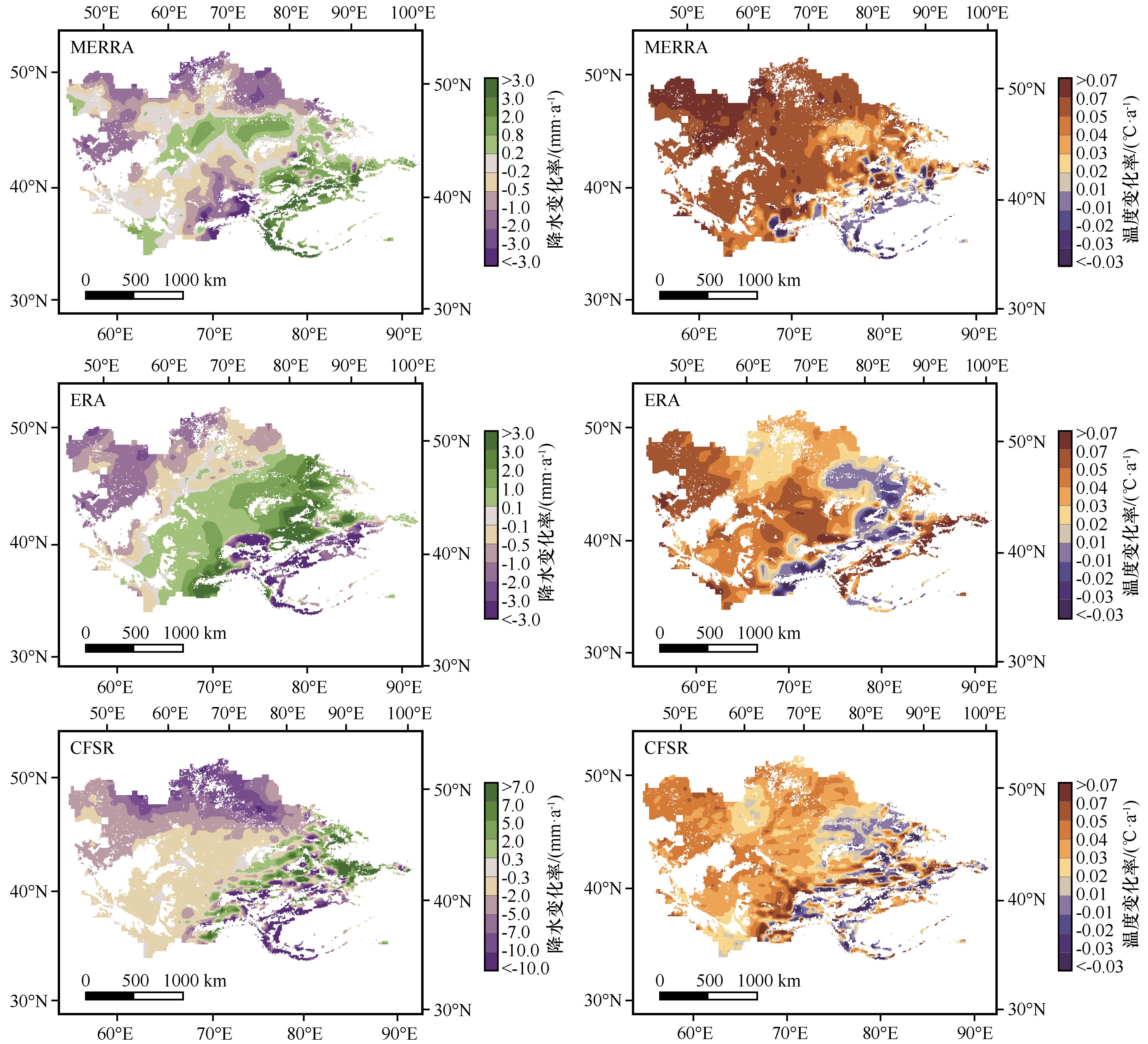
Fig.3 Spatial patterns of temporal trends of annual total precipitation and mean temperature over grasslands in Central Asia during 1982 to 2014 calculated from MERRA, CFSR and ERA-interim reanalysis datasets
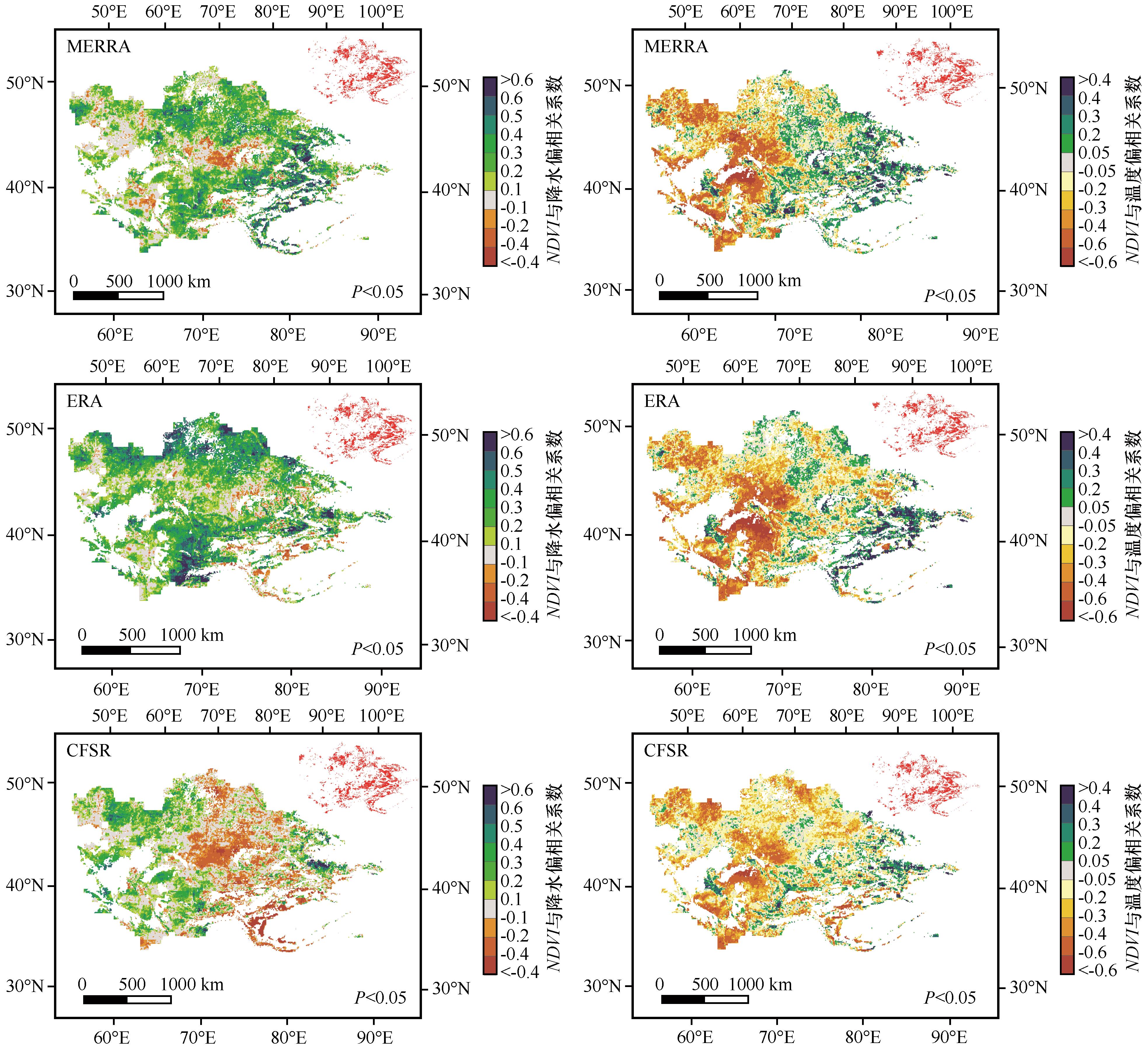
Fig.5 Partial correlations of NDVI with precipitation and temperature based on MERRA, ERA-interim and CFSRreanalysis datasets. Red areas in the small inserted maps indicated the correlations significant at levels of 0.05
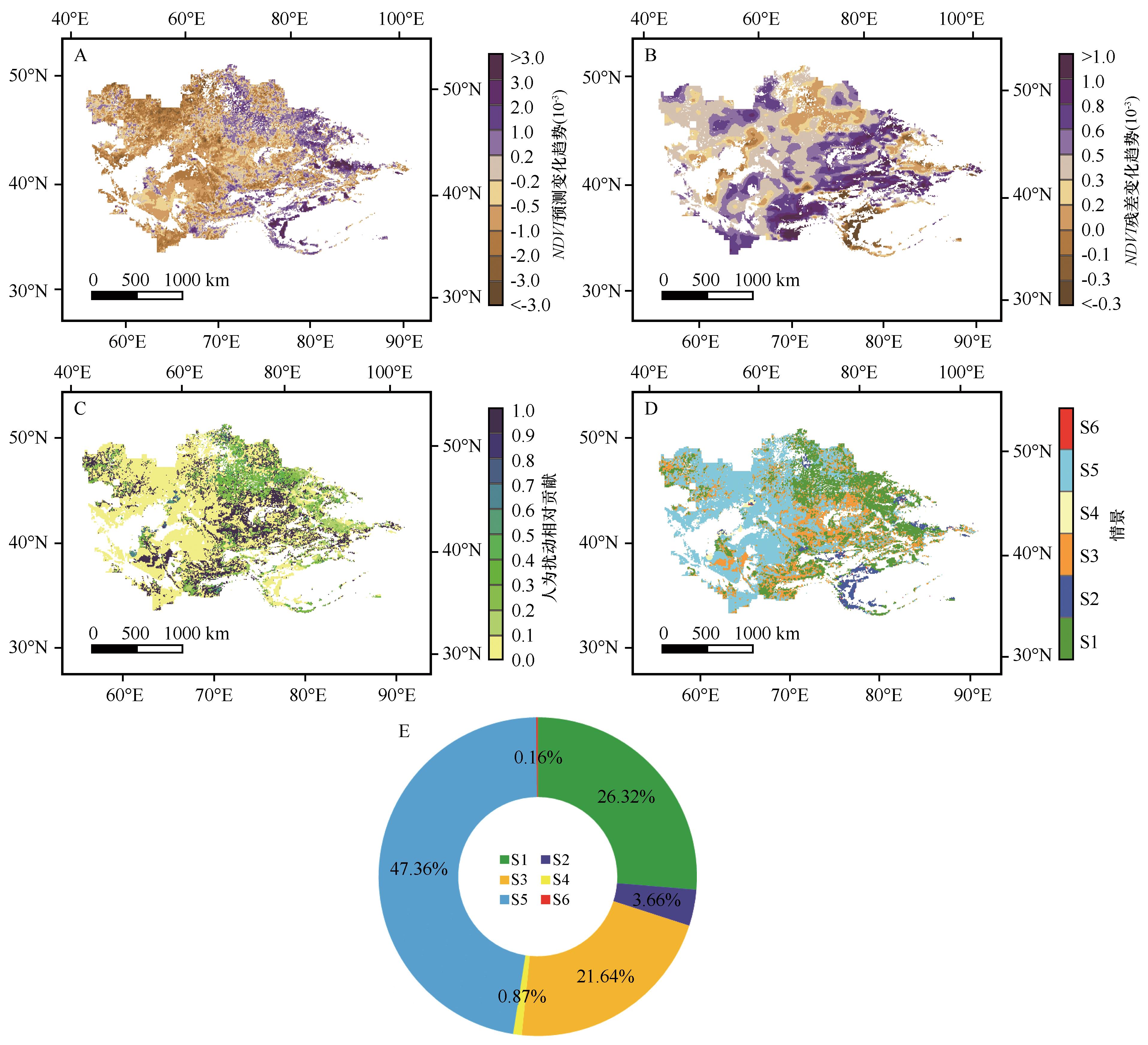
Fig.7 NDVI change caused by the CFSR climate factors (A) and by human activities (B), the relative contribution of human activities to NDVI (C), and the spatial distribution and proportion (circular, E) of different scenarios of the impact of climate and human activities on NDVI (D)
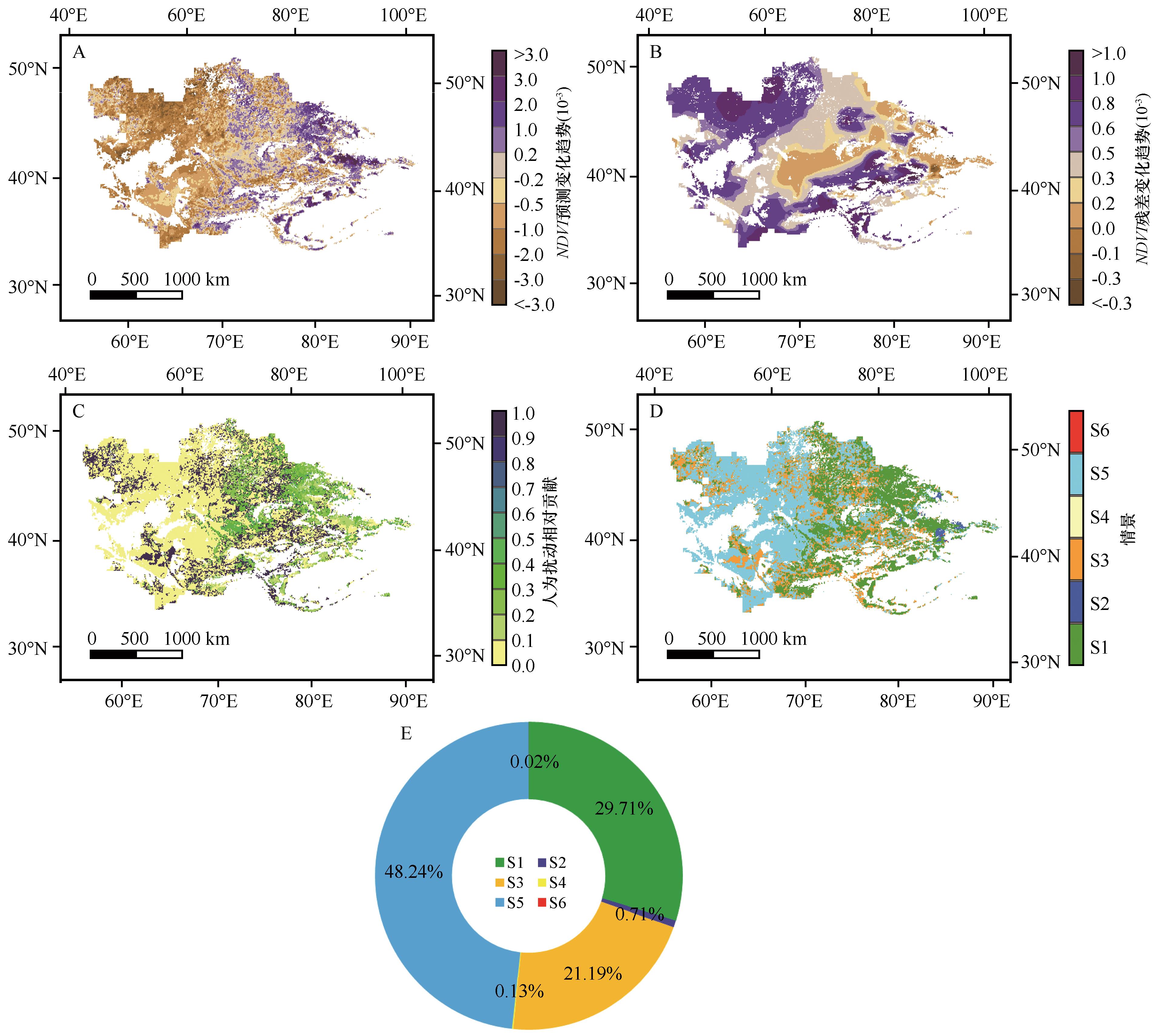
Fig.8 NDVI change caused by the ERA climate factors (A) and by human activities (B), the relative contribution of human activities to NDVI (C), and the spatial distribution and proportion (circular, E) of different scenarios of the impact of climate and human activities on NDVI (D)
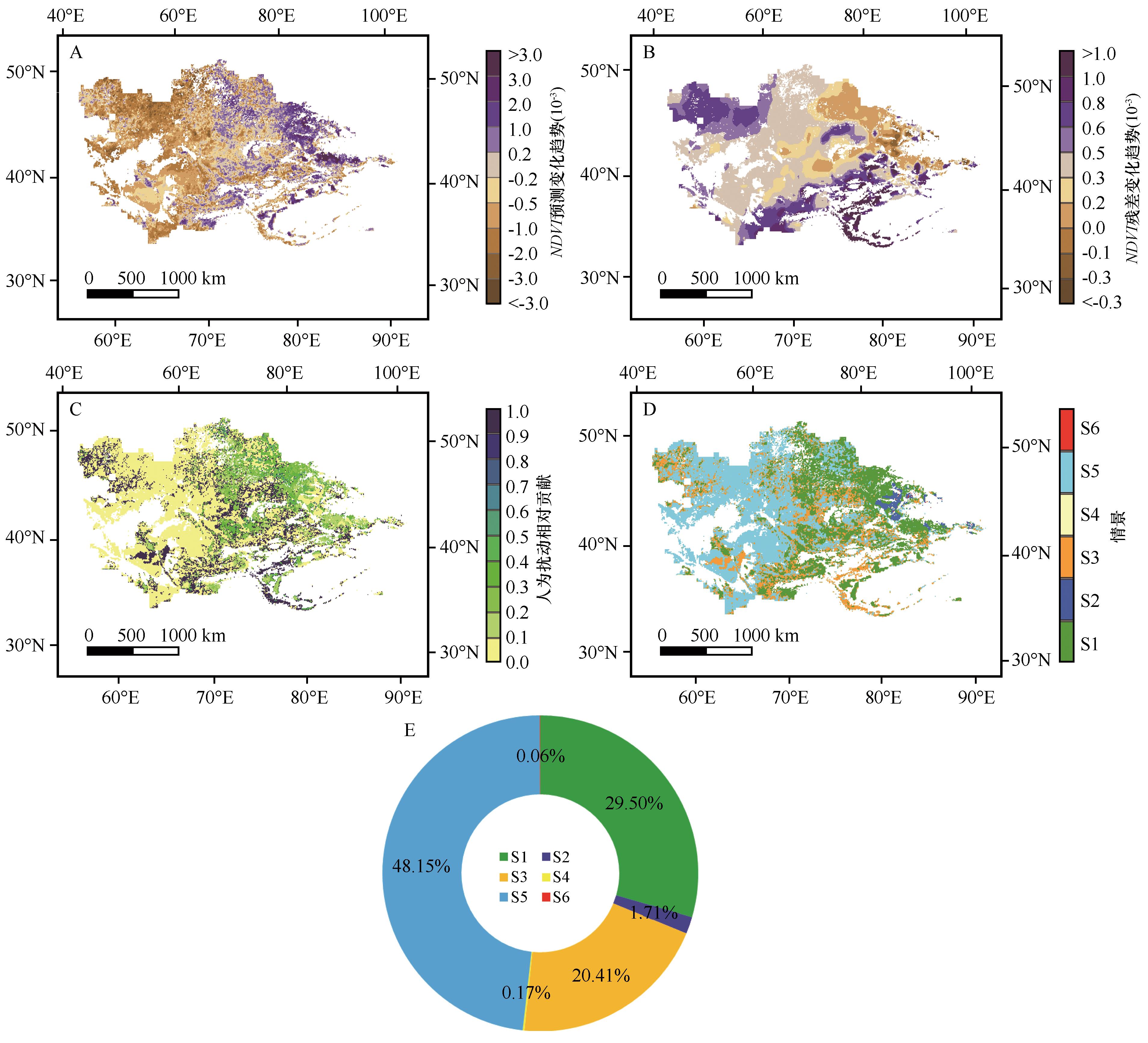
Fig. 9 NDVI change caused by the MERRA climate factors (A) and by human activities (B), the relative contribution of human activities to NDVI (C), and the spatial distribution and proportion (circular, E) of different scenarios of the impact of climate and human activities on NDVI (D)
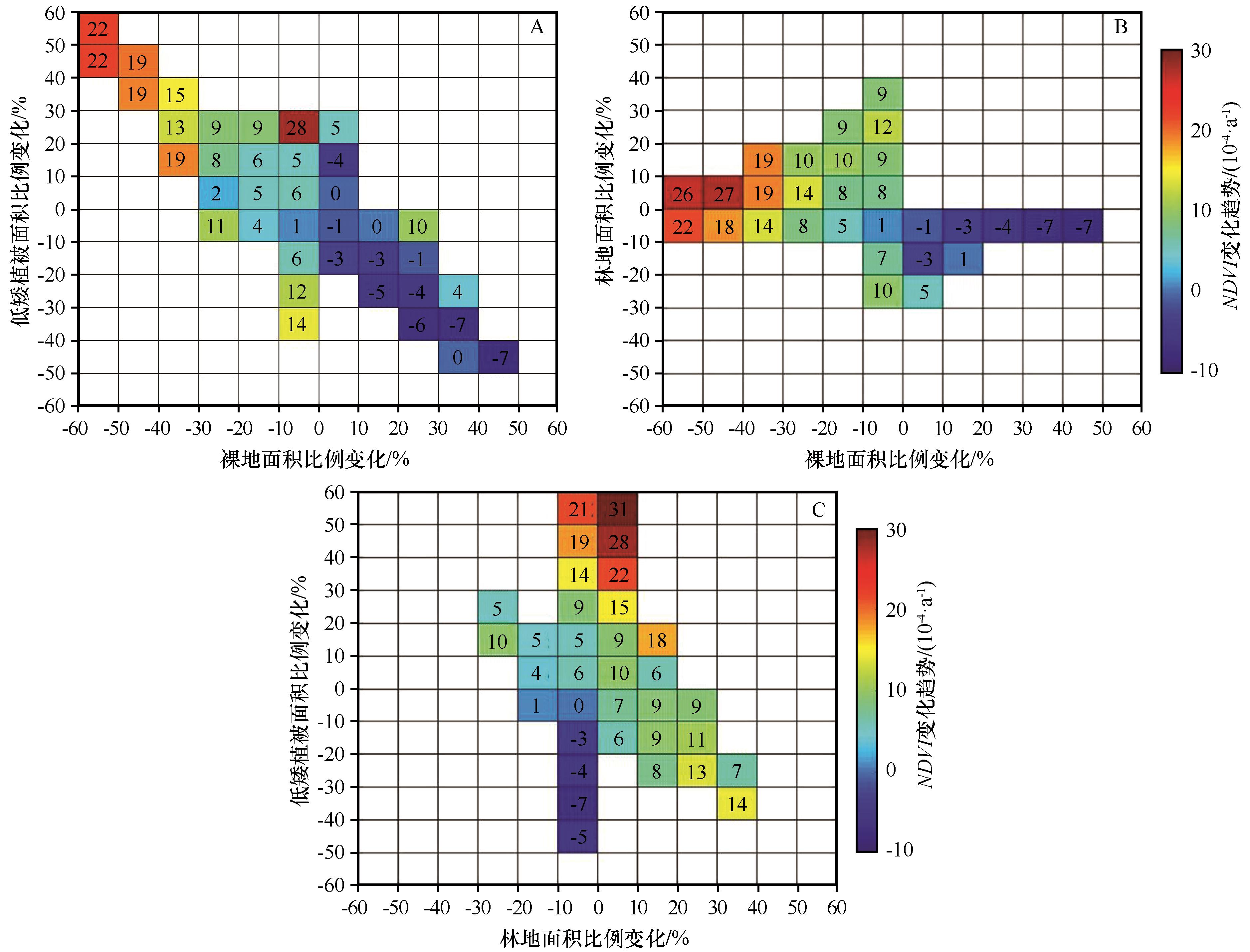
Fig.10 The impact of short vegetation coverage changes and bare change (A), tree canopy and bare change (B), short vegetation coverage changes and tree canopy changes (C) on the temporal trend of NDVI during 1982-2014
| 1 | Chen Y Z, Tao Y W, Cheng Y,et al.Great uncertainties in modeling grazing impact on carbon sequestration:a multi-model inter-comparison in temperate Eurasian Steppe[J].Environmental Research Letter,2018,13(7):14. |
| 2 | Hu Z Y, Zhang C, Hu Q,et al.Temperature changes in Central Asia from 1979 to 2011 based on multiple datasets[J].Journal of Climate,2014,27(3):1143-1167. |
| 3 | Jiang L L, Jiapaer G, Bao A M,et al.Monitoring the long-term desertification process and assessing the relative roles of its drivers in Central Asia[J].Ecological Indicators,2019,104:195-208. |
| 4 | Chen T, Bao A, Jiapaer G,et al.Disentangling the relative impacts of climate change and human activities on arid and semiarid grasslands in Central Asia during 1982-2015[J].Science of the Total Environment,2019,653:1311-1325. |
| 5 | Kerven C, Steimann B, Dear C,et al.Researching the future of pastoralism in Central Asia's mountains:examining development orthodoxies[J].Mountain Research and Development,2012,32(3):368-377. |
| 6 | 李小院,张圣微,王帅,等.放牧对退化草地近地面辐射的影响[J].中国沙漠,2022,42(1):223-233. |
| 7 | Christensen L, Coughenour M B, Ellis J E,et al.Vulnerability of the Asian typical steppe to grazing and climate change[J].Climatic Change,2004,63(3):351-368. |
| 8 | Paruelo J M, Puetz S, Weber G,et al.Long-term dynamics of a semiarid grass steppe under stochastic climate and different grazing regimes:a simulation analysis[J].Journal of Arid Environments,2008,72(12):2211-2231. |
| 9 | Sjogersten S,Rene van der Wal, Woodin S J.Impacts of grazing and climate warming on C pools and decomposition rates in Arctic environments[J].Ecosystems,2012,15(3):349-362. |
| 10 | Skiba U, Jones S K, Drewer J,et al.Comparison of soil greenhouse gas fluxes from extensive and intensive grazing in a temperate maritime climate[J].Biogeosciences,2013,10(2):1231-1241. |
| 11 | Solomon S, Qin D, Manning M,et al.Climate Change 2007:The Physical Science Basis[R].Cambridge,UK:Cambridge University Press,2007. |
| 12 | 詹瑾,李玉霖,韩丹,等.放牧对浑善达克沙地丘间低地植被群落及土壤的影响[J].中国沙漠,2019,39(6):184-191. |
| 13 | 韩其飞,罗格平,李超凡,等.放牧对新疆草地生态系统碳源/汇的影响模拟研究[J].生态学报,2017,37(13):4392-4399. |
| 14 | Balling R C.Impact of desertification on regional and global warming[J].Bullein American Meteorology Society,1991,72(2):232-234. |
| 15 | Varejao-Silva M A, Franchito S H, Rao V B.A coupled biosphere-atmosphere climate model suitable for studies of climatic change due to land surface alterations[J].Journal of Climate,1998,11(7):1749-1767. |
| 16 | Yoshioka M, Mahowald N M, Conley A J,et al.Impact of desert dust radiative forcing on Sahel precipitation:relative importance of dust compared to sea surface temperature variations,vegetation changes,and greenhouse gas warming[J].Journal of Climate,2007,20(8):1445-1467. |
| 17 | Gessner U, Naeimi V, Klein I,et al.The relationship between precipitation anomalies and satellite-derived vegetation activity in Central Asia[J].Global and Planetary Change,2013,110:74-87. |
| 18 | Mohammat A, Wang X H, Xu X T,et al.Drought and spring cooling induced recent decrease in vegetation growth in Inner Asia[J].Agricultural and Forest Meteorology,2013,178/179:21-30. |
| 19 | 张琪,袁秀亮,陈曦,等.1982-2012年中亚植被变化及其对气候变化的响应[J].植物生态学报,2016,40:13-23. |
| 20 | 朱士华,艳燕,邵华,等.1980-2014年中亚地区植被净初级生产力对气候和CO2变化的响应[J].自然资源学报,2017,32(11):1844-1856. |
| 21 | Yi C, Pendall E, Ciais P,et al.Focus on extreme events and the carbon cycle[J].Environmental Research Letters,2015,10:070201. |
| 22 | Stoy P C.Deforestation intensifies hot days[J].Nature Climate Change,2018,8:366-368. |
| 23 | Polley H W, Tischler C R, Johnson H B.Elevated atmospheric CO2 magnifies intra-specific variation in seedling growth of Honey Mesquite:an assessment of relative growth rates[J].Rangeland Ecology & Management,2006,59(2):128-134. |
| 24 | Vicente-Serrano S M, Gouveia C, Camarero J J,et al.Response of vegetation to drought time-scales across global land biomes[J].PNAS,2013,110(1):52-57. |
| 25 | Huang L, He B, Chen A F,et al.Drought dominates the interannual variability in global terrestrial net primary production by controlling semi-arid ecosystems[J].Scientific Reports,2016,6:24639. |
| 26 | Zhang C, Ren W.Complex climatic and CO2 controls on net primary productivity of temperate dryland ecosystems over central Asia during 1980-2014[J].Journal of Geophysical Research:Biogeosciences,2017,122(9):2356-2374. |
| 27 | 陈曦,姜逢清,王亚俊,等.亚洲中部干旱区生态地理格局研究[J].干旱区研究,2013,30(3):385-390. |
| 28 | 胡汝骥,姜逢清,王亚俊,等.中亚(五国)干旱生态地理环境特征[J].干旱区研究,2014,31(1):1-12. |
| 29 | Song X P, Hansen M C, Stehman S V,et al.Global land change from 1982 to 2016[J].Nature,2018,560(7720):639-643. |
| 30 | Chen J M, Ju W M, Ciais P,et al.Vegetation structural change since 1981 significantly enhanced the terrestrial carbon sink[J].Nature Communications,2019,10(1):4259. |
| 31 | 金凯,王飞,韩剑桥,等.1982-2015年中国气候变化和人类活动对植被NDVI变化的影响[J].地理学报,2020,75(5):961-974. |
| 32 | 许端阳,康相武,刘志丽,等.气候变化和人类活动在鄂尔多斯地区沙漠化过程中的相对作用研究[J].中国科学(D辑:地球科学),2009,39(4):516-528. |
| 33 | Zhang C, Li C F, Luo G P,et al.Modeling plant structure and its impacts on carbon and water cycles of the Central Asian arid ecosystem in the context of climate change[J].Ecological Modelling,2013,267:158-179. |
| 34 | Zhu S H, Li C F, Shao H,et al.The response of carbon stocks of drylands in Central Asia to changes of CO2 and climate during past 35 years[J].Science of the Total Environment,2019,687:330-340. |
| 35 | 朱士华,张弛,李超凡.基于BIOME-BGC模型的新疆牧区生态系统碳动态模拟[J].干旱区资源与环境,2016,30(6):159-166. |
| 36 | Obermeier W A, Lehnert L W, Kammann C I,et al.Reduced CO2 fertilization effect in temperate C3 grasslands under more extreme weather conditions[J].Nature Climate Change,2017,7(2):137-141. |
| 37 | Fang X, Guo X L, Zhang C,et al.Contributions of climate change to the terrestrial carbon stock of the arid region of China:a multi-dataset analysis[J].Science of the Total Environment,2019,668:631-644. |
| 38 | Alkama R, Cescatti A.Biophysical climate impacts of recent changes in global forest cover[J].Science,2016,351(6273):600-604. |
| 39 | 王娅,屈准,周立华.基于学者视角的禁牧政策成效解析与适时调整[J].中国沙漠,2020,40(5):209-219. |
| [1] | Xueping Chen, Xueyong Zhao, Ruixiong Wang, Zhiying Ning, Jiannan Lu, Siteng Zhao. Research advances on the impact of climate change and LUCC for water resources in the northern agro-pastoral zone in China [J]. Journal of Desert Research, 2022, 42(3): 170-177. |
| [2] | Yulai Gong, Shaoxiu Ma, Weiqi Liu. A comparative study of machine learning and statistical models in climate downscaling in the Shiyang River Basin [J]. Journal of Desert Research, 2022, 42(1): 196-210. |
| [3] | Benli Liu, Wanyue Peng, Shulin Liu, Ting Yang. Estimation on the dust lift amount and source contribution of the heavy dust weather in mid-March 2021 over Central East Asia [J]. Journal of Desert Research, 2022, 42(1): 79-86. |
| [4] | Yanhui Lei, Guodong Ding, Zimeng Li, Wenfeng Chi, Guanglei Gao, Yuanyuan Zhao. Land use/cover change and its ecosystem service value response in the Beijing-Tianjin sandstorm source control project area [J]. Journal of Desert Research, 2021, 41(6): 29-40. |
| [5] | Xiaomei Zhang, Heling Jin, Bing Liu. Environment changes in the Hobq Desert since the Last Glacial Maximum [J]. Journal of Desert Research, 2021, 41(5): 81-93. |
| [6] | Xiaohui Ma, Jiangli Pang, Xiaokang Liu, Dan Ding, Xiaoxiao Yue, Feifei Jia. Early and Middle Holocene climate change inferred by Wayaogou Section in the Southeastern Mu Us Desert [J]. Journal of Desert Research, 2021, 41(5): 71-80. |
| [7] | Yongtao Ma, Xiaozong Ren, Huifang Hu, Min Liu, Qi Meng. Vegetation dynamics and its driving force in Otindag Sandy Land based on Geodetector [J]. Journal of Desert Research, 2021, 41(4): 195-204. |
| [8] | Lanying Han, Qiang Zhang, Pengli Ma, Youheng Wang, Tao Huang, Jianying Jia, Xin Wang, Xiaowei Wang, Weiping Liu, Danhua Li, Guoyang Lu, Pengcheng Huang, Bing Bai. Characteristics of drought disasters risk in the Yellow River Basin under the climate warming [J]. Journal of Desert Research, 2021, 41(4): 225-234. |
| [9] | Youheng Wang, Dan Tan, Lanying Han, Danhua Li, xin Wang, Guoyang Lu, Jingjing Lin. Review of climate change in the Yellow River Basin [J]. Journal of Desert Research, 2021, 41(4): 235-246. |
| [10] | Xiaohui He, Jianhua Si, Chunyan Zhao, Chunlin Wang, Dongmeng Zhou. Potential distribution of Hippophae thibetana and its predicted responses to climate change [J]. Journal of Desert Research, 2021, 41(3): 101-109. |
| [11] | Yuanzheng He, Wenda Huang, Xin Zhao, Peng Lv, Huaihai Wang. Review on the impact of climate change on plant diversity [J]. Journal of Desert Research, 2021, 41(1): 59-66. |
| [12] | Di Deng, Zebin Zhao, Yuan Ma. Modeling of species distribution with GIS in arid regions: take Caragana korshinskii for example [J]. Journal of Desert Research, 2020, 40(5): 74-80. |
| [13] | Zisha Wang, Yunfa Miao, Yongtao Zhao, Fang Li, Yan Lei, Mingxing Xiang, Yaguo Zou. Characteristics of microcharcoal in the lake surface sediments in the northern margin of Qaidam Basin of China and its environmental significance [J]. Journal of Desert Research, 2020, 40(4): 10-17. |
| [14] | Han Chao, Xiao Shengchun, Ding Aijun, Teng Zeyu. Radial growth climatic response characteristics and tree ring climate records of conifer species at south margin of Tengger Desert, China [J]. Journal of Desert Research, 2020, 40(2): 50-58. |
| [15] | Li Xiang, Su Zhizhu, Ma Yijuan, Zhang Caixia, Liu Miaomiao. Holocene climatic instability record in the southeastern margin of Mu Us Desert [J]. Journal of Desert Research, 2020, 40(2): 109-117. |
| Viewed | ||||||
|
Full text |
|
|||||
|
Abstract |
|
|||||
©2018Journal of Desert Research
Tel:0931-8267545
Email:caiedit@lzb.ac.cn;desert@lzb.ac.cn
Support:Magtech